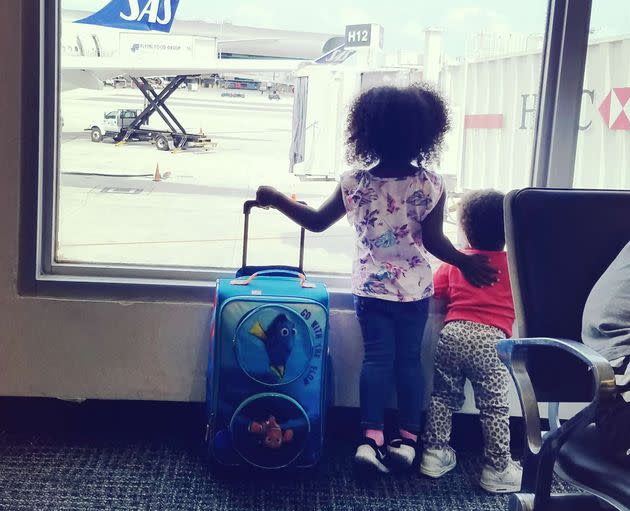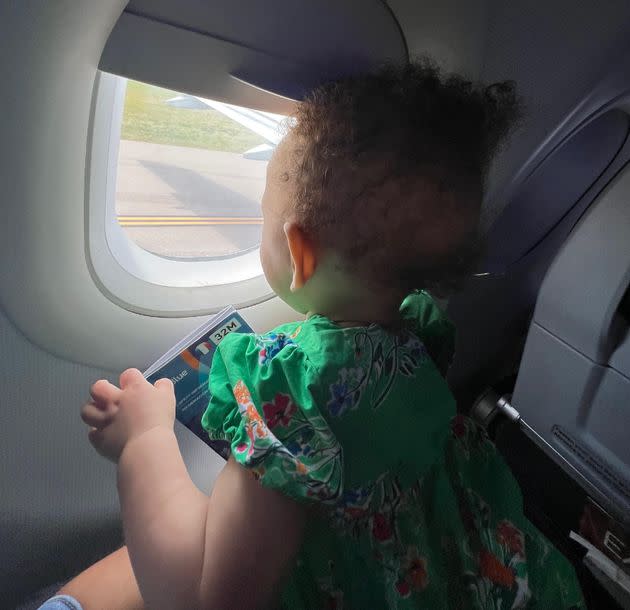This Is The Best Age To Take A Baby On An Airplane
I remember how nervous my wife and I were when we took our firstborn on a airplane for the first time. We were terrified that he would spend the entire flight to Chicago screaming, earning us the titles of Worst Passengers — and, even more humiliatingly, Bad Parents.
We carefully packed the diaper bag, checked in the car seat and the stroller, and held our breath as the plane took off. We realized there was no turning back now. Per advice we’d gleaned online, we fed the baby as the aircraft climbed to cruising altitude to help relieve the pressure in his ears. Then he slept — for the entire flight. Didn’t make a peep.
A flight attendant smiled at his peaceful face, nuzzled in my wife’s arms. “At that age, they just sleep through the whole thing,” she said with nonchalant nostalgia.
A fellow passenger remarked that she hadn’t even noticed he was on the flight.
Our son was about three months old at the time of that trip, and, given our smooth experience then — and the challenges we faced once he became a toddler — I’d say that the best time to take a baby on an airplane is ASAP.
We asked several moms who travel frequently with their kids for their thoughts on the question. Here’s what they had to say.
The ideal time to fly with a baby
Courtney Orgias, who posts about her family’s travels on Instagram, told HuffPost: “Our daughter’s first plane ride was at 10 weeks and it was so smooth and easy.”
“It really isn’t as difficult as one would think,” Orgias said. “We flew about four hours and she slept almost the entire way.”
In comparison, her other child didn’t board a plane until he was two, and while everything was fine, it was simply a more challenging situation. “He was restless and it was such a new experience, but with snacks and snuggles, we had a great flight,” Orgias said.
Another traveling mom, Stephanie Claytor, made similar comparisons between the infant and toddler stages as they relate to air travel.
“As a nursing mom, I think the ideal age to fly with a baby is between four months until the baby stops nursing,” Claytor told HuffPost. “Nursing the baby to sleep upon takeoff leads to a smooth ride with baby sleeping through a short flight.”
Flying with a toddler who is no longer nursing, on the other hand, “is more difficult and requires you to brings lots of snacks and activities,” she said. Her son didn’t fly until 22 months. On his first trip, they lucked out and ended up getting their own row of seats.
“He was very active in our row and I had to keep him engaged with toys,” Claytor said.
Monet Hambrick, who also posts on Instagram about her adventures with her two children, ages 8 and 10, says the best time to fly with a baby is “before they start crawling.”
“They’re so easy, they’re so peaceful,” she explained. “They’re not trying to wiggle their way out and crawl around the airplane.”
Hambrick’s older daughter flew at just 6 weeks old, and her younger daughter at only 11 days. She describes both flights as “easy.”
“Honestly, at that age, they sleep so much, so it was pretty uneventful,” Hambrick told HuffPost.

Other advantages to flying with an infant
In addition to the frequent naps and limited mobility, there are some other pluses to traveling with a younger baby.
An early start puts them — and you — on track for less travel anxieties later on. “The sooner you fly with your baby, the less nerves and anxiety you’ll have built up about trips in the future,” Orgias said.
Having a less-mobile child is easier not only on the aircraft but during the arduous path through the airport. “It’s much easier to pick up and go,” Orgias said. “You can put the kids in a stroller or cart and be on your way. Once they’re running around and have more autonomy, wrangling them in the airport can be more difficult.”
You may also decide to fly with a tiny baby because it beats traveling the same route by car. This is the calculation Hambrick’s family made when they moved from New York to Florida when their daughter was only 11 days old.
“I didn’t want to drive with her,” Hambrick said, and she figured that “two hours on a plane is much better than 16 hours in a car, having to pull over constantly.”
On a plane, you can nurse as much as you like (potentially nonstop!) without having to ask the pilot to make an unplanned landing.

But there are some medical considerations to note
If your baby was born premature or has any health issues, you’ll definitely want to check in with your pediatrician before making your reservations. It may also be worth talking to them about communicable diseases such as the flu, or where your baby is at in their series of vaccinations.
It’s natural for new parents to prioritize concerns about the baby, but don’t forget that someone who just gave birth is also at a heightened risk for certain medical complications.
“Even if you had a normal pregnancy, there are still certain risk factors to travel after having a baby,” Dr. Christine Greves, an OB-GYN at Orlando Health Women’s Institute in Florida, told HuffPost.
These include blood clots, postpartum hemorrhage and preeclampsia, Greves said. “Although rare,” she said, “you may want to be mindful of how long your flight is where you are traveling.” Would medical help be readily available at your destination?
In addition, if you’ve had a C-section, you’ll be advised not to lift heavy objects — such as a suitcase — for 6-8 weeks.
Overall, Greves recommended that you try to move your legs regularly while in flight (to prevent blood clots) and travel with someone who can help you out. Hambrick, for example, took her mother along with her when she flew from New York to Florida with her newborn.
A good way to remind yourself to move around while in flight is to focus on staying hydrated. All that fluid will get you moving to and from the bathroom at regular intervals.
Here are some tips for a smooth ride:
Give yourself some extra time. “With a baby, you just never know,” Hambrick said. They might spit up or have a blowout diaper and need their clothes changed. Either of these messes could mean you may need to change as well — so Hambrick recommends packing an extra outfit for yourself in a carry-on, just in case.
She also said she has run into issues traveling with breast milk. You are allowed to bring it on-board, but if a TSA agent isn’t familiar with the protocol you might have to ask to speak to a supervisor, thereby prolonging your passage through security. Claytor noted that you need to take the breast pump out of its bag when passing through security, or else you may have to devote extra time to having an agent examine it.
Nurse or bottle feed at take-off and landing. This helps relieve the pressure in a baby’s tiny ears. It can also help you feel like you are doing something proactive to make the flight go smoothly.
Don’t overpack the diaper bag. While you want to be prepared for anything, you also need to be able to reach into the diaper bag and find a specific item. “The easier you can get to what you need, the better,” Orgias said. “Most places sell diapers and wipes, so don’t get worried about running out,” she added.
Try not to stress. When she first started traveling with her kids, Orgias worried about making a scene. “I didn’t want to disturb other passengers or have people looking at me sideways if the baby cried or my toddler had a tantrum,” she said. But no amount of worrying is going to stop crying or tantrums from happening. At the end of the day, she said, “ten minutes of your child crying won’t ruin a five hour flight.” Staying calm yourself, she added, will help small children remain calm as well.
Use a baby carrier. Since a stroller or car seat can be bulky and hard to maneuver, it can be easiest to check them in first thing and use a baby carrier to navigate the airport hands-free — something that’s particularly helpful if you have older children. Claytor noted that “when flying internationally with a lap child, you can’t check-in online ... and have to wait in line to check-in at the counter,” so it may be just as easy to check in items there. Hambrick mentioned using the baby carrier so that she could use the restroom while traveling solo with a little one.
Check your car seat or stroller in a bag. Hambrick found that if you put it in a bag, you can throw a few extra items into the car seat before you check it. This is a handy tip if you’re struggling to squeeze everything you need into your carry-ons.
Schedule flights strategically. If your baby has a regular nap time, take advantage of it. Hambrick said she tries to book morning flights. The first flights of the day are less likely to get cancelled, she said, and if they do end up cancelled you have more time before the last flight of the day takes off.
Know when to ask for, and accept, help. If you find yourself in a pinch, perfect strangers — often other parents — can really come through for you. Hambrick has had flight attendants offer to hold her baby while she uses the restroom, and once had to walk up and down the aisles looking for other similarly-sized babies whose parents might gift her diapers and wipes when she accidentally left her diaper bag at the gate before a ten hour flight. “Parents, they know life happens and they don’t judge me, and we kind of just laughed about it,” she said.

